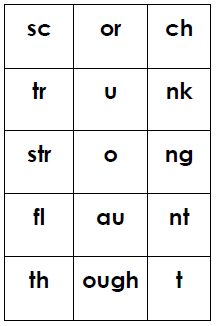- MN ABE Connect
- Archive
- Developmental Word Study: Part 2
 December 14, 2020
December 14, 2020
Developmental Word Study: Part 2
Marn Frank, ATLAS Literacy & STAR Coordinator Kristine Kelly, ATLAS Literacy & ELA CoordinatorDuring October and November, the University of Minnesota’s Center for Reading Research (MCRR) hosted a series of five webinars focused on developmental word study. Last week’s article, Developmental Word Study: Part 1, shared characteristics of Emergent and Beginning Level Readers along with mostly free ideas or resources for remote instruction. Part 2 shares the characteristics of Transitional and Upper Level Readers (at approximately NRS Levels ESL 4-5: Low/High Intermediate, Advanced ESL, ABE 3-4: Low/High Intermediate, and ABE 5: Low Adult Secondary) and even more ideas or resources from MCRR faculty, ATLAS staff, and MN ABE teachers.
Transitional Level Readers
Transitional Level Readers are ready to expand their phonics knowledge to include vowel controlled r/l/w patterns (ar, er, or, ir, ur, etc.), consonant clusters (-ing, -ang, -ong-, -ung, -ink, -ank, -unk), vowel diphthongs (oy, oo, ow, aw, ou, oi, au, etc.), irregular spellings (soft/hard c+g, kn-, wr-, -ph-, -mb, etc.) and inflectional endings (-s/es, -ed, -ing, -er, -est). Their independent word reading and spelling significantly improve as does their reading and writing fluency. They are also better able to read and comprehend more non-fiction and complex texts.
From MCRR:
- Teach new consonant/vowel patterns and contextual sight words from flashcards, electronic whiteboards, or annotation (see Flippity)
- Use Jamboard for letter-sound segmenting and blending of taught words
- Model and guide free “Within Word Pattern” sorts at http://educationextras.com/wordstheirway.html
- Select and purchase leveled print or digital copies of Words Their Way™
- Use breakout rooms and word banks for sentence or paragraph writing
- Dictate words for spelling practice on paper and provide immediate screen feedback
- Use letter-sound boxes to teach 5-7 letter words with more complex or irregular patterns

From ATLAS/MN ABE:
- Scan pages, screen share, model and guide practice from this free ATLAS resource:
- Introduce inflectional endings that form related, two-syllable words: -ed, -ing, -es, -er, -est
- Introduce compound words to teach the strategy of ‘chunking’ or training the brain to see decodable word parts
- Screen share Every Day Edits and guide students’ reading and finding of spelling, usage, and punctuation errors
- Assign extra practice outside of class from:
- IXL (Third and Fourth Grade language arts)
Upper Level Readers
Upper Level Readers hold solid knowledge of phonics and spelling patterns for one-syllable words and are ready to learn the 6 syllable types and 5 rules, accented and unaccented syllables, prefixes (in-, un-, mis-, dis-, re-, etc.), derivational suffixes (-ly, -er/-or, -ion, -able/-ible, etc.), Latin roots, and Greek forms found in multi-syllable words.
From MCRR:
- Model and guide “Syllables and Affixes” sorts at http://educationextras.com/wordstheirway.html
- Select and purchase leveled print or digital copies of Words Their Way™
- Use breakout rooms and word banks for sentence or paragraph writing
From ATLAS/MN ABE:
- Fully explain to students the value and importance of learning how to read, recognize, and spell multi-syllable words. Knowing morphology (morphemes or word parts and their meanings) highly supports academic word and text reading and understanding of word and text meaning.
- Teach the syllabication and prefix/root/suffixes patterns (or chunks) in academic or content-specific words introduced during vocabulary lessons
- Scan pages, screen share, model and guide practice from purchased* or free ATLAS resources:
- Megawords*
- Making Sense of Decoding and Spelling (accessible from LINCS or ATLAS)
- Intermediate Word Study
- Morpheme Matrices
- Screen share, model, and guide slides sets from this NEW ATLAS electronic resource: e-Advanced Alphabetics
- Screen share Every Day Edits and guide students’ reading and finding of spelling, usage, and punctuation errors
- Assign extra practice outside of class from:
- IXL (Fifth to Eighth Grade language arts)
Don’t forget to check out Part 1 of this article, where we explore characteristics of, and resources for, Emergent and Beginning Level Readers!
Newsletter Signup
Get MN ABE Connect—the official source for ABE events, activities, and resources!
Sign UpArticle Categories
- ABE Foundations/Staff Onboarding
- ACES/Transitions
- Adult Career Pathways
- Assessment
- CCR Standards
- Citizenship
- COVID-19
- Cultural Competency
- Digital Literacy/Northstar
- Disabilities
- Distance Learning/Education
- ELA
- Equity/Inclusion
- ESL
- HSE/Adult Diploma
- Listening
- Math/Numeracy
- Mental Health
- Minnesota ABE
- One-Room Schoolhouse/Multilevel
- Professional Development
- Program Management
- Reading
- Remote Instruction
- Science
- Social Studies
- Speaking/Conversation
- Support Services
- Teaching Strategies
- Technology
- Uncategorized
- Volunteers/Tutors
- Writing